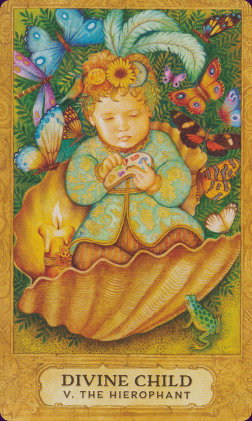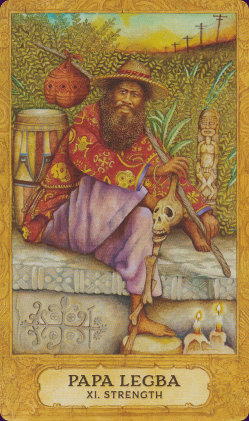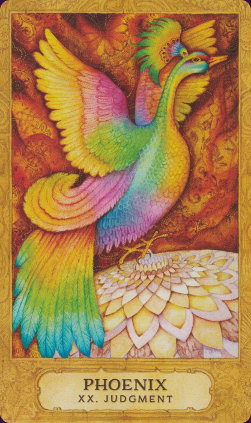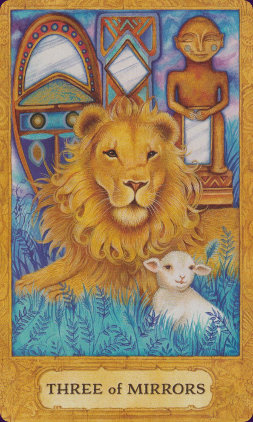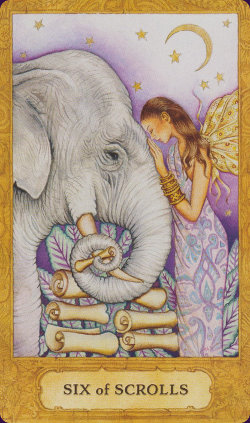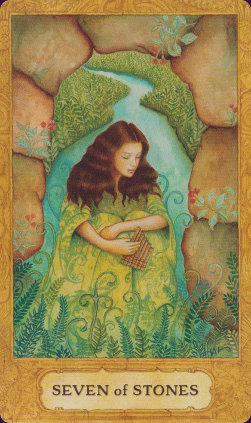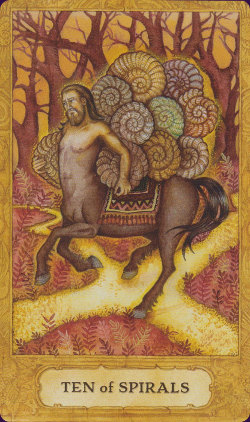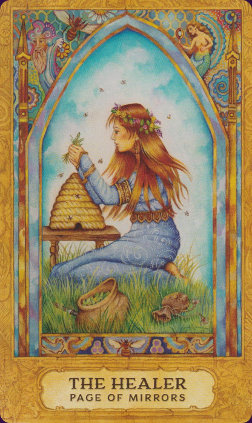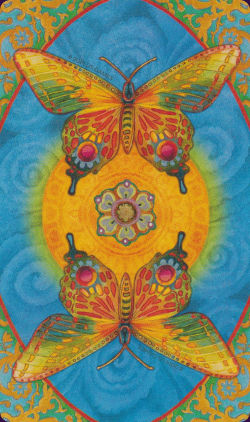Chrysalis Tarot Deck Review
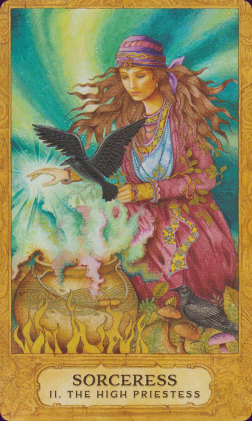
The Chrysalis Tarot is a 78-card deck of luminous, detailed paintings with a Pagan feel and rich symbolism from author Toney Brooks and artist Holly Sierra. A beautiful and unique stand-alone deck, it takes a new and non-traditional approach to tarot, with new archetypes in the majors and new illustrations in the minors and court cards.
Deck Type: Tarot Deck Cards: 78
Creators: Holly Sierra, Toney Brooks
Publisher: US Games 2014
Retailers
See Price at Amazon.comSee Price at Amazon.co.uk
See Price at Amazon.ca
Chrysalis Tarot Review by Mythic Silence
The Chrysalis Tarot is a 78 card deck illustrated by Holly Sierra and written by Toney Brooks. The deck is published by U.S. Games Systems, Inc. The cards measure 2.75 x 4.75 inches and the backs are reversible.
Quality:
This Tarot is packaged in a standard tuckbox with a 60 page companion booklet. The cardstock is durable and the lamination is subtle. The deck feels wonderful in your hands and the cards swish and slide merrily, making it lovely for fanning. It is a hardy specimen, and I’m not hesitant to shuffle it.
Extra Materials (Booklet):
Keyword attributes are listed for each card in the deck, and the descriptions are thorough in spite of the limited space. Brooks explains the significance of many of the colors and symbols within the cards, and the meanings that he provides are constructive and often introspective. He describes the energies of the card and gives suggestions for what action it may be prompting. I found the descriptions to be helpful in the context of a reading, not just on paper, and they coincide with the imagery.
The booklet also includes a pentagram spread that is simple, straightforward, and useful. It is general enough to be applicable to a variety of inquiries, but not so abstract that it yields only vague information. I used it for my first reading with this deck and was very pleased with the results.
Artwork:
This deck’s art style is beautiful and dignified, yet fun and full of whimsical vitality. The illustrations are rendered with great technical skill and filled with meaningful details. The intricacies and symbols spark a plethora of insights, and it is easy to glean unique associations that go beyond the guidebook.
This imagery is very cohesive, and yet there is a healthy amount of variation in the illustrations. The Chrysalis Tarot features people, animals, deities, and mythological creatures. I like this because it keeps the deck from being pigeonholed into a very specific theme or style.
The use of color in this deck is fantastic, and it is often utilized to convey a specific meaning or concept. For example, in the Three of Scrolls, Brooks explains that violet’s color vibration “connects you to the Otherworld’s unseen purposes.” Even when the color is not explicitly stated to be of particular importance in the booklet, it is incredibly evocative. I particularly resonated with the palette in the Four of Spirals. This illustration depicts a cottage with a night sky overhead and bright tree branches and grasses. For me, the combination of light and dark colors creates a haunting and magical image.
I think that the borders on this deck are pleasant and unobtrusive. They match the artwork and frame it well. The captions are also appropriately sized and the font is legible.
Content:
This deck deviates from the Rider Waite tradition, though many of the meanings and concepts within the cards still line up with the classic associations. It is certainly not a Rider Waite clone, but I would not consider this deck to divert into the territory of an oracle either. To me, this deck offers new twists and representations of the tradition that are welcome and refreshing. Often a card highlights an aspect on the spectrum of traditional meanings and chooses to visually depict that aspect and focus on it. For example, the Hierophant, which is renamed the Divine Child, highlights the individual responsibility of spiritual growth and the necessity of critical thinking and openness. The card depicts a young child sitting within a shell and surrounded by symbols of transformation, such as butterflies and frogs. In this way the card emphasizes a different part of the Hierophant’s spectrum of meaning that I believe works well within the structure of the Tarot.
The Major Arcana cards in this deck are renamed, but the captions also list the original titles to minimize confusion. The concepts coincide with many traditional themes of the Major Arcana, so the changes are less intimidating than they may seem at first. For example, Justice (card 8 in this deck), is renamed Ma’at, and the accompanying illustration is of the goddess, who has strong and familiar connections with the idea of justice.
In the Minor Arcana Spirals are Wands, Stones are Pentacles, Scrolls are Swords, and Mirrors are Cups. The suits maintain traditional elemental associations, though Brooks does associate Spirals (Wands) with rational thought and Scrolls (Swords) with intuition. To me it felt like there was a bit of crossover between these two suits, but the composition of the deck keeps these slight systematic alterations from becoming problematic. I also admire that this deck is so creative with the suit of Cups. The reflective nature of water and the receptive attribute of the suit make mirrors an excellent suit symbol.
The re-imagined court cards are another wonderful aspect of this deck. The booklet describes them as “a delightful ensemble of medieval merrymakers.” This refreshing take on the court cards successfully breaks free of the royal ranks. One of my favorites is the Corsair as the Knight of Spirals. I think that this character embodies the traditional Knight of Wands perfectly. Additionally, both sexes are equally represented within the court – to which I give thunderous applause. I also love that each court card has a meaningful animal association rather than one creature or animal representing an entire suit. The Chrysalis Tarot definitely makes working with court cards fun and satisfying!
At first the booklet may need to be kept handy to explain some of the less common symbols. For instance, the Six of Stones depicts a tree of life with stone ornaments hanging from its branches. The green stones are emeralds and the gold stones are heliodors. The significance of these stones coincides with the traditional meaning of charity that the card represents. However, without a strong knowledge of stone meanings, this was not apparent to me at first. That being said, the deviations in this deck are thoughtful, inspiring, and memorable. In my experience the deck is very readable and welcoming.
Conclusion:
The Chrysalis Tarot delivers an inspired and exquisite interpretation of the Tarot. This deck brings forward fascinating nuances that make it a great choice for readings, study, and meditation. I recommend it to anyone who is seeking a deck with a unique vision.
Chrysalis Tarot Review by Arianna
I just got the newly released Chrysalis Tarot and I love it, though as with just about every other deck, I do have a few small reservations. First the good: it's gorgeous, brightly colorful, uplifting, positive, fanciful, lovely - even the card backs are gorgeous and uplifting, with colorful butterflies over a sun-like center and blue spiraled background with beautifully ornate corners. I was totally drawn into this deck immediately - the colors called me in a soothing, yet upbeat way, and most of the card designs were compelling, and interesting enough to get my thoughtful attention. Artist Holly Sierra's art is decorative without being cloying or (for the most part) too cutesy and clearly a lot of thought has been put into the interpretations of the cards and their artistic interpretations (by writer Toney Brooks). I did a few spreads with the deck, and each time the results were meaningful and positive.
The deck changes the names of the four suits and the court cards, though that isn't problematic in itself. My biggest observation (rather than complaint) is that some of the artistic renderings do not follow the mainstream Rider-Waite or do not clearly express them, and so the LWB is essential for full understanding of the deck. A simple example is The Sun card, which has a tear falling from its eye. I wondered why, as The Sun in Rider-Waite is one of the most positive cards in the deck. Looking in the LWB, I read that "...Sun sheds a fatherly tear because so many of his children neglect beauty, truth and justice in favor of materialism, power and dogma." It goes on to say "... even a lamenting Sun is an excellent card to have in your reading." So it does follow the traditional meaning in fact, though you wouldn't quite get that just looking at the card on its own.
There are a number of other cards where the meanings are difficult to deduct from just looking at the cards - take the 6 of Spirals (Wands), which in Rider-Waite shows a person riding clearly in triumph amongst a crowd. In Chrysalis, there are six decorative flags hanging from a tree with the sun in the background. Not a clear presentation of the core meaning of this card; if I were a beginner, I would have to definitely look in the LWB for clarification, which does note this is a card of success. So the deck doesn't so much deviate from the meanings of Rider-Waite as it doesn't quite clearly express those meanings in all of its depictions.
That said, all in all I
think this deck is fabulous. I love its positiveness and
beauty and it's a joy to look at and read with. Highly
recommended for everyone, though beginners in particular
should pay attention to the LWB that comes with it for
guidance in interpretation.
Chrysalis Tarot Review by Bonnie Cehovet
The “Chrysalis Tarot” is a 78 card Tarot deck that comes with a 60 page companion book (LWB). It follows traditional format, with the following changes.
The Major Arcana has been retitled:
The Fool – Merlin
The Magician – Ravens
The High Priestess – Sorceress
The Empress – Gaia
The Emperor – Green Man
The Hierophant – Divine Child
The Lovers – The Lovers
The Chariot – Herne the Hunter
Justice – Ma-at
The Hermit – Storyteller
The Wheel of Fortune – Wheel
Strength – Papa Legba
The Hanged Man – Celtic Owl
Death – Ariadne
Temperance – Golden Flower
The Devil – Bella Rosa
The Tower – Kali
The Star – Elpi
The Moon – Moon
The Sun – Sun
Judgment – Phoenix
The World – Psyche
The four suits are Stones (Pentacles), Mirrors (Cups), Spirals (Wands), Scrolls (Wands). The court cards in this deck fill the function of a Troupe (an ensemble of medieval merrymakers):
The Minstrel: King of Pentacles, King of Stones
The Artiste: Queen of Pentacles, Queen of Stones
The Illusionist: Knight of Pentacles, Knight of Stones
The Acrobat: Page of Pentacles, Page of Stones
The Sojourner: King of Cups, King of Mirrors
The Watcher: Queen of Cups, Queen of Mirrors
The Dreamer: Knight of Cups, Knight of Mirrors
The Healer: Page of Cups, Page of Mirrors
The Companion: King of Wands, King of Spirals
The Muse: Queen of Wands, Queen of Spirals
The Corsair: Knight of Wands, Knight of Spirals
The Mime: Page of Wands, Page of Spirals
The Poet: King of Swords, King of Scrolls
The Weaver: Queen of Swords, Queen of Scrolls
The Visionary: Knight of Swords, Knight of Scrolls
The Pilgrim: Page of Swords, Page of Scrolls
The deck and companion book come in a beautiful box with an image of the moon and butterflies on the front, and the Page of Mirrors (The Healer) on the back. In his introduction, Brooks talks about the concept of achieving your destiny in the Tarot. He also talks about the balance between ego and psyche.
The characters found in the imagery of this deck represent Otherworld characters and archetypes (Major Arcana), as well as the day to day of life … inspiration for personal reflection, intuition, and imagination (The Pips/Numbered cards), and the troupe of medieval troubadours, representing real life messengers (the Court Cards).
The cards are presented by text only (no images). Each Major Arcana card includes the new title, the traditional title, attributes, and a discussion of the card, and the symbols within it. Each Pip (numbered card) includes the card number, suit, keyword, and a discussion of the card. The Troupe (Court) Cards include the new title, the traditional title, attributes, role, and a short discussion of the card.
For example:
II Sorceress
Traditional Title: The High Priestess
Attributes: Mysticism, Magic
Sorceress Morgan Le Fay is pictured in vibrant hues of mysticism and magic. Her talisman represents the pomegranate, food of the Otherworld, and a symbol of the Triple Goddess. We can feel the fruitful energy swirling in the background as it explodes in a crescendo of bursting light from Morgan’s hand. Woven spirals symbolize the infinite transformative energy of the sorceress.
In your reading, Morgan points to one of your challenging encounters in attaining transformation. Morgan does her magic as the curtain that separates the seen and the unseen worlds. The ravens, insatiably curious when magic is active, swoop in to flavor her cauldron with magical synchronicity, those coincidences that confirm you’re on the right track.
At the end of the companion book (LWB) a five card Pentagram spread (including significator) is presented.
The cards are 2 ¾” by 4 ¾”. The card backs show gold and blue imagery in each of the four corners, with a blue background in the center, covered in spirals. In the center of the card is a gold circle, with a mandala in the middle. Multi-colored butterflies appear on either end of the gold circle. The cards are reversible.
The card faces shows a gold border, with the new title and the traditional title in black lettering against a white background at the bottom of the card. The coloring on the cards is a beautiful pastel, with the imagery drawn from myth, Celtic, Pagan, Egyptian, and VooDoo traditions.
In Ravens (The Magician), we see black ravens sitting in a tree that features an open eye in the trunk. They are playing a game with pearls, which represent moonlight, mysticism, and synchronicity.
One of the cards that I feel represent the traditional archetype well if Green Man (The Emperor). We see the face of the Green Man in the foliage, looking down on a birds nest, with his companion butterfly in the upper left hand corner.
Bella Rosa (The Devil) is another card that represents the traditional archetype very well. The mystical figure wears a mask as she looks out from the card, which symbolizes who she really is deep within. She wars A beautifully done hat, while carrying a rose in her right hand, and a mirror in her left hand. We see an infinity symbol to her right.
The Aces are very simple cards. The Ace of Stones shows a sacred megalith.
The Ten of Mirrors is a beautiful card, showing a rainbow colored dove of peace in flight in the center, against a blue background. The dove carries ten mirrors that represent an emerging new cycle.
The Pilgrim (Page of Scrolls) shows a figure dressed in a lilac tunic with a darker lavender skirt. She carries a lantern in her right hand, a staff in her left. In the upper left hand corner we see a butterfly, with an animal of some type behind her right shoulder.
The Companion (King of Spirals) shows a male figure, seated on a stool, with a small bird at his feet.
The Weaver (Queen of Scrolls) shows a female figure, in a light lavender dress, at work. There is an orange tabby cat in a basket at her feet.
I found the imagery well done, but not always reflecting the traditional meaning (such as the tear the Sun is shedding). The inclusion of both the new title and the traditional title on the card to me is disruptive. If you want to retitle a card, then use that title, and that title alone, on the card.
Redefining the Court Cards as Troupe seems to diminish, rather than expand, the nature of the card.
I found this deck nicely illustrated, and the notes in the LWB well written. While this deck is easy to read with, I would not use it as a learning deck.
Complete Details of Chrysalis Tarot
Creators: Holly Sierra, Toney BrooksPublisher: US Games 2014
Deck Type: Tarot Deck
Cards: 78
Major Arcana: 22
Minor Arcana: 56
Deck Tradition: Mixed
Minor Arcana Style: Unique Scenes Without Suit Symbols
Suits: Stones (Pentacles), Mirrors (Cups), Spirals (Wands), Scrolls (Swords)
Court Cards: Page, Knight, Queen, King
Major Titles: 0 - Merlin, 1 - Ravens, II - Sorceress, III - Gaia, IV - Green Man, V - Divine Child, VI - Lovers, VII - Herne The Hunter, VIII - Ma'at, IX - Storyteller, X - Wheel, XI - Papa Legra, XII - Celtic Owl, XIII - Ariadne, XIV - Golden Flower, XV - Bella Rosa, XVI - Kali, XVII - Elpi, XVIII - Moon, XIX - Sun, XX - Phoenix, XXI - Psyche
The Fool is 0
Strength is 11
Justice is 8
Card Size: 2.75 x 4.75 in. = 6.99cm x 12.07cm
Card Language: English
Card Back: Reversible
Back Design: Multi-coloured mirrored design of a butterfly
Companion Material: 60-page little white booklet.
Rating: 20/20 or
Similar Decks to Chrysalis Tarot
Theme: Pagan & Wiccan< Previous Deck · Back to Top · Next Deck >
Home > Tarot Reviews > Chrysalis Tarot Review

